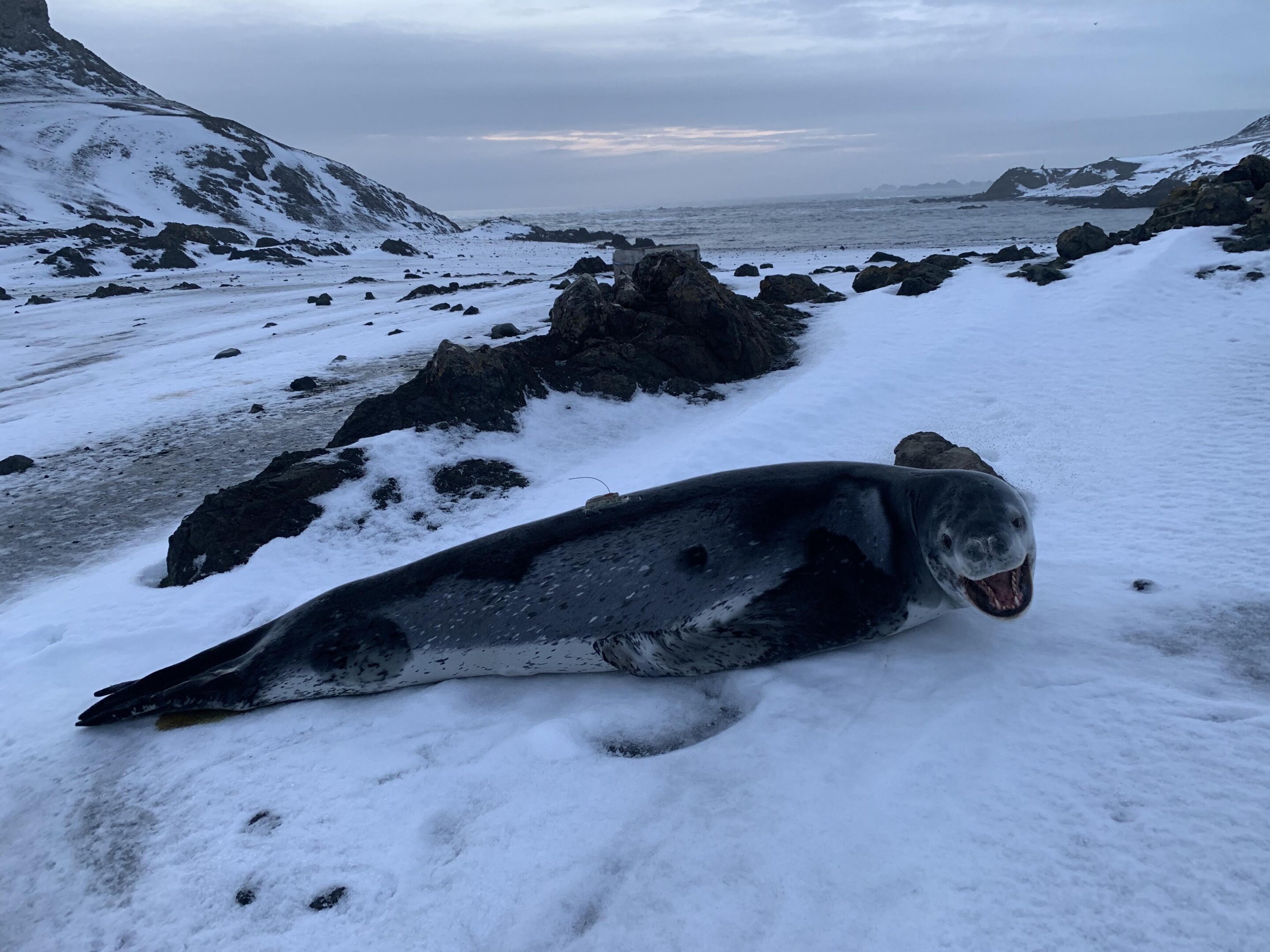Baylor University marine biologist Sarah Kienle, Ph.D., has always been fascinated by leopard seals. These prehistoric, reptilian-looking seals are often portrayed as scary villains in movies such as “Happy Feet” and “Eight Below,” but little is known about their basic biology. The combination of the extreme climate in Antarctica, the species’ solitary habits and their lethal reputation makes leopard seals one of the most difficult top predators to study on Earth.
Kienle, assistant professor of biology at Baylor, and her colleagues, including fellow biology researcher Stephen Trumble, Ph.D., set out to provide baseline data on the ecology and physiology of this enigmatic marine predator.
In a first-of-its-kind study funded by the National Science Foundation and published in the journal Frontiers in Marine Science, Kienle and colleagues formed a large collaboration that brought together researchers from the government, U.S.-based universities and international institutions with one shared goal: to learn more about leopard seals. Over the course of two years, the research group studied 22 leopard seals off the Western Antarctic Peninsula, an area rapidly warming and changing. They weighed and measured each seal and followed each seal’s activities and dive patterns using satellite/GPS tags.
In the study Kienle and the team documented the flexible behaviors and traits that may offer leopard seals the resilience needed to survive the extreme climate and environmental disturbances occurring around Antarctica.
“This study greatly increases our understanding of leopard seals’ life history, spatial patterns and diving behavior,” Kienle said. “We show that these leopard seals have high variability (or, flexibility) in these different traits. Across the animal kingdom, variability is vital for animals adapting and responding to changes in their environment, so we’re excited to see high variability in this Antarctic predator.”
Among the research team’s discoveries detailed in the journal article:
1) Adult female leopard seals are much larger than adult males; in fact, females are 1.5 times larger and longer.
- The team measured one of the largest leopard seals ever, an adult female they nicknamed “Bigonia,” who weighed 540 kg (1,190 lbs.).
- Female-biased sexual dimorphism (where females are larger) is unusual among marine mammals, a diverse group that includes polar bears, whales, dolphins, seals and sea lions, but leopard seals are the most extreme example of female-biased dimorphism among the 130+ species of marine mammals.
- Why females are larger than males is not known, although Kienle explained other studies show that larger females are better at defending feeding areas, as well as stealing prey from smaller seals. Larger females also eat bigger, energy-rich prey, including fur seals and penguins, while males and smaller females often eat smaller prey like krill and fish. This suggests that the larger body size in adult females is beneficial and offers a selective advantage that Kienle will continue to explore.
2) From the movement data, female leopard seals spent more time “hauled out”—or coming out of the water to rest on ice or land—than males.
- Two adult female leopard seals in this study spent two weeks straight hauled-out on ice in the middle of the ocean, not eating and not getting in the water. Kienle and colleagues suggest that this two-week haul-out period is when female leopard seals give birth and nurse their pup.
- At the end of the two weeks, females return to water and begin diving for food again, and, at the same time, they likely wean their pup. It’s a short period to spend with their pups because the leopard seal is doing all of these really energetically demanding things without any food.
3) Male and female leopard seals swim short and long distances in both coastal and open-ocean habitats.
- One seal only traveled 46 km from where the team worked with the seal, staying in and around islands off the Antarctic Peninsula.
- Another seal, however, traveled 1,700 km during that same period away from the tagging location, swimming to an island more than a thousand kilometers away.
4) Leopard seals of both sexes are short, shallow divers—diving to an average of 30 meters and taking three-minute-long dives.
- Other seals can dive thousands of meters deep and hold their breath for more than 40 minutes. However, the research team recorded the longest and deepest dive ever recorded for leopard seals made by a male nicknamed “Deadpool,” who dove to 1,256 meters for 25 minutes.
“It’s interesting to see such variation [in movements and dive behavior] in a relatively small number of animals. To me, this means that leopard seals are highly flexible in their movement patterns, and that’s a really good thing in terms of adapting to changes in your environment,” Kienle said.
What’s next for this team of leopard seal biologists? Kienle said the team continues to analyze additional data from these same 22 leopard seals for publication. Kienle also is excited to compare how the leopard seals from this study compare to other populations of leopard seals across the Southern Ocean.
“I have so many more questions, and I’m excited to continue learning about leopard seals for years to come. There’s so much more to discover about this incredible Antarctic predator,” said Kienle, who leads the Comparative Ecophysiology of Animals Lab at Baylor that focuses on understanding how different animals work in the context of their environment.
New study provides information on the secret life of an enigmatic Antarctic apex predator
Sarah S. Kienle et al, Plasticity in the morphometrics and movements of an Antarctic apex predator, the leopard seal, Frontiers in Marine Science (2022). DOI: 10.3389/fmars.2022.976019
Citation:
Team provides novel baseline data on leopard seals, mysterious apex predators of Antarctica (2022, August 24)
retrieved 25 August 2022
from https://phys.org/news/2022-08-team-baseline-leopard-mysterious-apex.html
This document is subject to copyright. Apart from any fair dealing for the purpose of private study or research, no
part may be reproduced without the written permission. The content is provided for information purposes only.
For all the latest Science News Click Here
For the latest news and updates, follow us on Google News.

